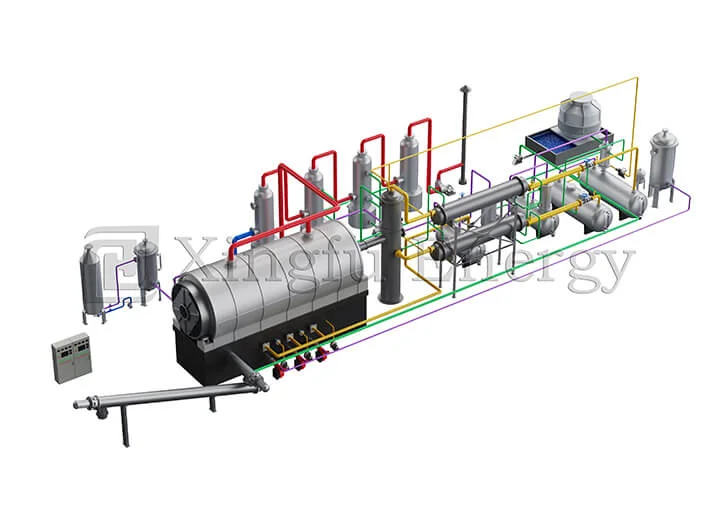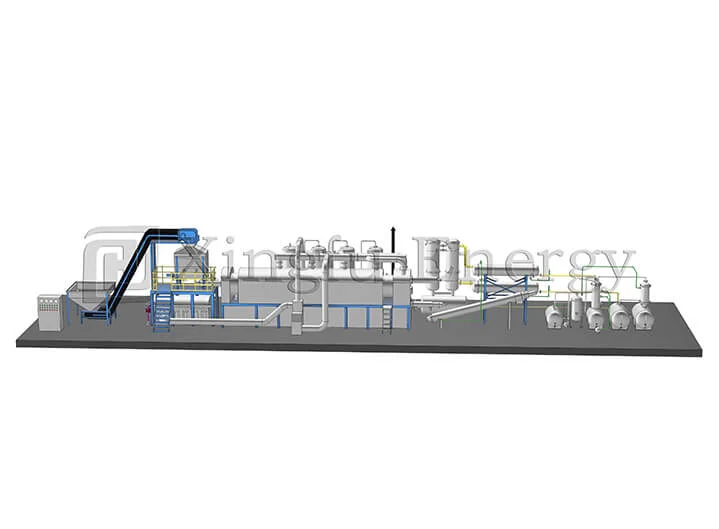Pyrolysis is a heat-based process. It breaks down natural materials at high heat without air. This method splits big molecules into smaller pieces. It makes useful items like oil, gas, and carbon black. Pyrolysis works by heating stuff—like old tires or plastics—in a closed container. No air means no burning. So, the material turns into its basic parts. The results are gathered using a cooling system. Each item can be used for different jobs in factories.
Pyrolysis is super helpful in tire recycling. It turns used tires into things we can use again. The process makes pyrolysis oil. This oil can be fuel or turned into other products for factories. It also makes carbon black. This can be used to make rubber items or as a coloring agent. Plus, it pulls out steel wire. This wire can be reused in building or making stuff. Pyrolysis helps with tire disposal pick up issues. It also supports saving resources and keeping the environment clean.
Batch pyrolysis plants handle materials in separate groups, not all at once. These setups are small. They have a reactor, a feeding system, a cooling part, and a way to take out products. Workers put the material in the reactor by hand or with some help. Then they start the heating. After the process, the system cools down. Then they take out the products. The batch setup lets you work with different types of materials easily.

Batch pyrolysis plants have some great points:
Saves Money: These setups cost less to start than continuous ones.
Flexible: They can handle many materials, like whole tires or plastics, without much prep.
Easy to Use: Batch systems are simple to run and take care of. They’re good for small businesses.
Low Starting Cost: Perfect for new companies learning how to start a tire recycling business.
Batch pyrolysis plants have some downsides too:
Less Speed: They need to cool and empty between batches. This slows things down.
Needs More Workers: Loading and unloading by hand takes more people.
Smaller Output: These systems work better for small projects because they can’t handle too much at once.
Semi-continuous pyrolysis plants are a middle step between batch and fully continuous setups. They have an automatic feeding system. This lets them add materials without stopping. But they still process in batches inside the reactor. After one batch is done, another can start right away. The system has better cooling tools. These help get products out faster.
Faster Work: They don’t stop as much between batches. So, they handle more material than batch plants.
Less Work for People: Automatic feeding means fewer workers are needed.
Can Grow: These systems are good for medium-sized businesses that want to get bigger.
Cleaner Operation: They have better tools to control pollution and follow rules.
Semi-continuous pyrolysis plants have some challenges:
Costs More to Start: They need more money than batch setups.
Harder to Run: More automatic parts mean you need skilled workers and regular fixes.
Needs More Space: These plants take up more room than batch ones.
Qingdao Xingfu Energy Equipment Co., Ltd., located in Qingdao City, offers customization services tailored to meet diverse operational needs.
Continuous pyrolysis plants work without stopping. They’re different from batch or semi-continuous setups. They use a conveyor or automatic feeding system. This keeps adding materials, like waste tires, into the reactor. Inside, the material breaks down at high heat with no air. This stops burning and turns the material into pyrolysis oil, carbon black, steel wire, and gas.
The continuous design means no waiting for cooling or unloading. Products are taken out all the time through advanced cooling systems. New material keeps going in. Using many cooling steps helps get more fuel oil. This makes the process very efficient. It’s perfect for big operations that need to handle a lot.
Continuous pyrolysis plants have many good points for tire recycling businesses:
Works Faster: They don’t stop, so they get more done.
Makes More: These plants can handle bigger amounts than batch or semi-continuous ones.
Saves Workers: Automation means you don’t need as many people. This cuts costs.
Follows Rules: They have better tools to control pollution and meet environmental laws.
Saves Money Over Time: Features like hot air heating and heat reuse lower running costs.
Continuous pyrolysis plants have some tough parts:
High Starting Cost: Setting up a fully automatic system costs a lot.
Hard to Fix: The advanced machines need skilled workers to keep them running.
Needs Space: These systems take up more room than batch or semi-continuous ones.

Tire disposal pick up services are key for getting materials to pyrolysis plants. You can work with local pick-up services. Or you can set up your own network. This ensures you always have old tires to process. Pyrolysis turns these tires into useful things like oil, carbon black, and steel wire.
Pyrolysis oil can be fuel for factory furnaces. It can also be turned into diesel. Carbon black is used to make rubber items or as a coloring agent. Steel wire can be reused in building projects.
Study the Market: Look at local needs for recycled tire products. Find people who will buy them.
Pick the Right Plant: Choose between batch, semi-continuous, or continuous systems. Think about your budget and size of work.
Get Money: Look for ways to pay for the starting costs.
Get Permits: Follow environmental rules and get the right licenses.
Set Up Supply Lines: Work with tire disposal pick up services to get a steady supply of tires.
Train Workers: Teach your team how to run and care for the plant to work better.
Batch pyrolysis plants are great for small projects. They cost less to set up. They can handle different materials without much prep. Semi-continuous systems are good for medium-sized businesses. They help you grow without jumping to a fully continuous setup.
Continuous pyrolysis plants are best for big projects. They can handle a lot at once. Their efficiency makes them perfect for large industrial work.
Batch systems cost the least to start. But they’re not great for long-term costs. They need more workers and have more downtime. Semi-continuous setups are a middle option. They’re more efficient but cost more to start.
Continuous systems need a big investment at first. But they save money over time. Automation and less energy use make them cheaper to run.
Batch plants need to stop often. They load and unload materials a lot. This means more fixing over time. Semi-continuous systems stop less. But they still have breaks.
Continuous pyrolysis plants are the best for long-term work. They don’t stop much. But they need regular care from skilled workers to keep running well.
Pyrolysis turns waste tires into useful things like oil, carbon black, and steel wire. It also helps the environment.
Think about your budget and work size (small or large). Also, check material supply and how automatic you want the system (batch or continuous).
They handle a lot, work fast with automation, and don’t stop much compared to other types.
These services bring a steady supply of old tires to recycle using pyrolysis technology.
For more information on advanced pyrolysis solutions tailored to your needs, contact Qingdao Xingfu Energy Equipment Co., Ltd., located in Qingdao City—a high-tech enterprise specializing in innovative industrial solutions since 2010 in Shandong Province.